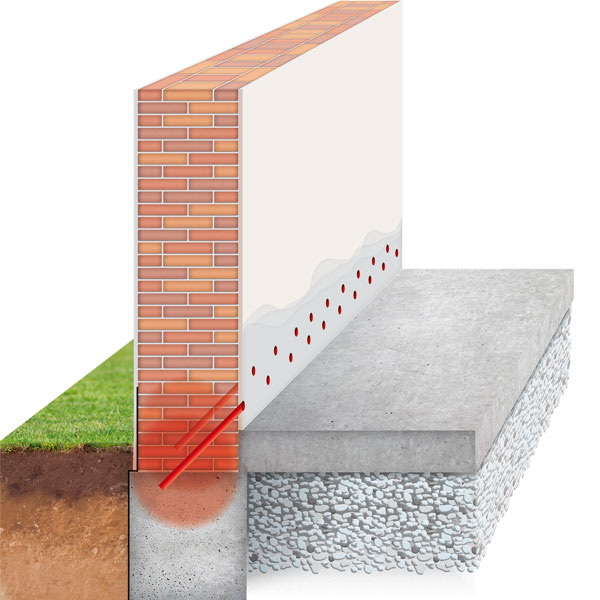What is capillary rising damp?
Capillaries are tubes or elongated cavities with a very small internal diameter. Due to the effects of physics, water is able to resist the pull of gravity and rise up inside these cavities of its own accord. The theoretical capillary rise is an impressive 14 metres! In practice, this means that moisture can rise up from underground via the foundations and seep up the walls. Damp (basement) areas, plaster damage and masonry defects are the consequences.
In order to prevent damp from rising, nowadays appropriate measures are usually put in place during the construction phase. Where these are defective or, in the case of older buildings, not present at all, mibag offers efficient assistance with the subsequent addition of a horizontal barrier.
horizontal barriers can be deployed in the injection process
When installing a horizontal barrier via a pressure injection process, bore holes near ground level are used to insert a suitable injection agent into the masonry based on requirements. This quickly spreads via narrow cavities and pores, blocking the path of rising damp and enabling permanent draining. Depending on the condition of the masonry different
Deployable injection agents:
Vialit MTS LF is a solvent-free product with an oily consistency. It has a hydrophobic and pore-sealing effect and is injected into the masonry under pressure through prepared 32mm bore holes. The OFI-certified system is suitable for sealing all masonry, but offers financial benefits for mixed masonry structures more than for any other type.
HydroBloc-SI 709 is a reactive concentrate of silane that is injected into 18mm bore holes, preferably into solid brick walls. Due to its low viscosity it also seeps into the smallest pores of the building construction, entailing a pore-narrowing and hydrophobic effect.
Both injection agents can be injected without predrying and independent of the degree of moisture penetration into the masonry. In contrast to non-pressurised methods, with the mibag system, the injection agent is pressed into the smallest cavities using precise, specialist pumps.


Injection process: the horizontal barrier inserted protects against rising damp.
Horizontal barrier by cutting through the masonry
With mechanically produced horizontal barriers the masonry is cut through via wet or dry cutting. Various different types of barrier layers can be inserted into the resulting kerf.
Bitumen: after preparing the kerf bitumen sheets are brought in, enabling straightforward connection to horizontal and vertical building seals. The remaining gap is then friction-locked and sealed with a fast-acting, high-strength shotcrete using a guniting process. In exceptional structural cases (thrust absorption) burled stainless steel sheeting can be used section by section.
Antique mortar: the top product from Neubauer is gunited fully and securely into the cut kerf and inhibits the rise of capillary damp without the use of other sealants. Because of its absolute material conformity the antique mortar is specifically suited for use with listed properties.

Mechanical process: bitumen (picture) or antique mortar inhibits the damp from rising.